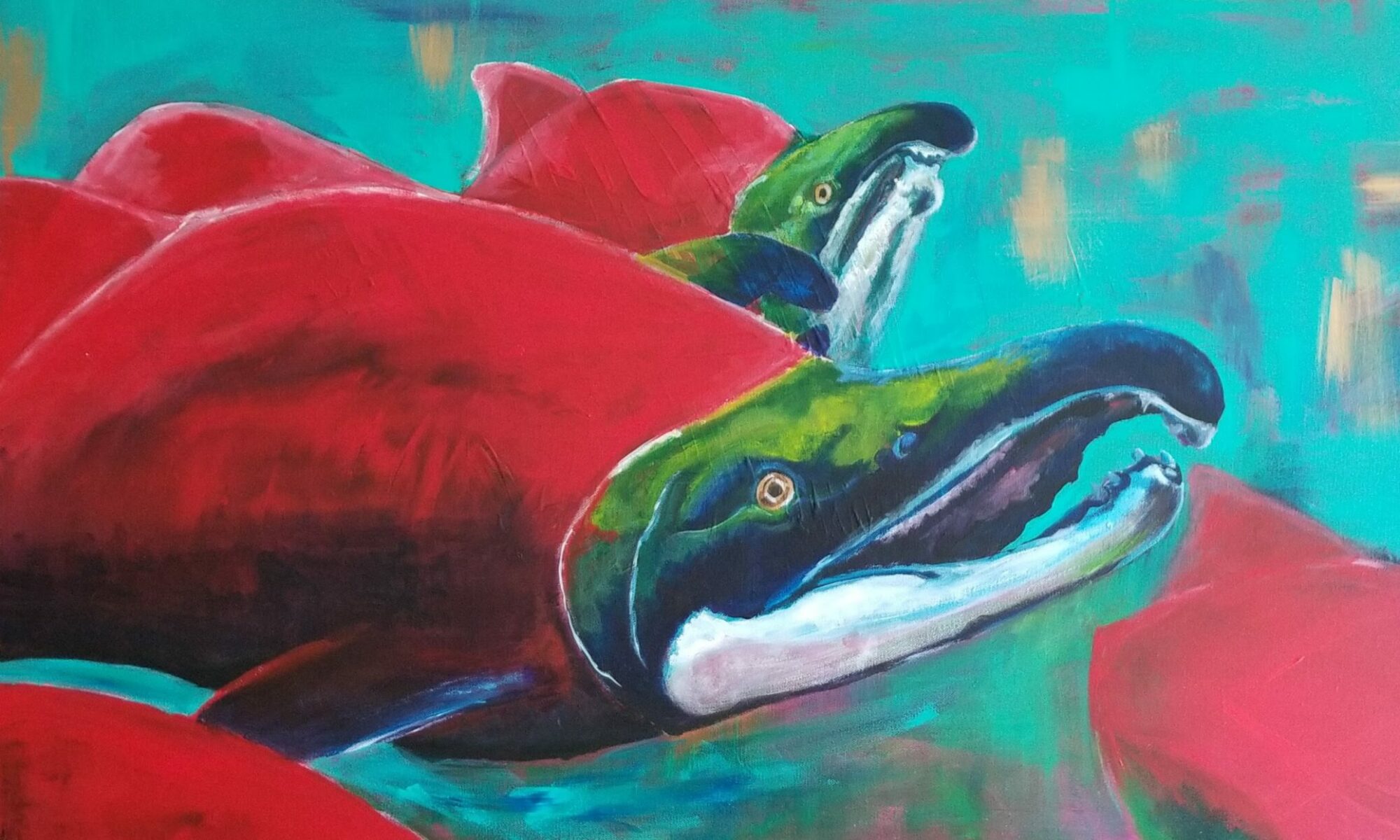FIN 201 Unit 1
Who knew I could fly! Check out my Green Screen Experimental Video! I am learning how the video magic works!
FIN 200 Unit 2
FIN 200 Unit 1
FIN 135 Unit 1
FIN 145 Unit 3
FIN 145 Unit 2
FIN 145 Unit 1
FIN 140 Unit 3
Artist Talk – Carey Newman
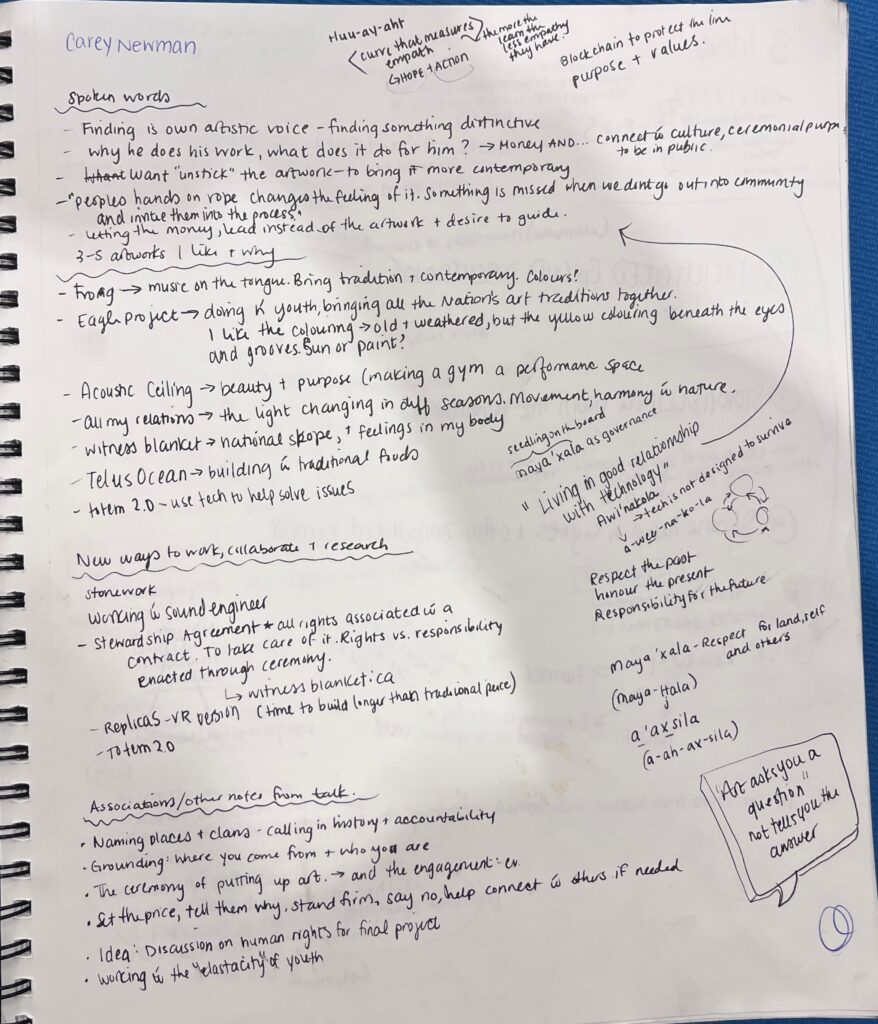
Ideation – 3 Brainstorms
Goal: highlight the role that temporary migrant workers play in our community and economy. Celebrate them and cast them as heros, not as slaves.
Means of doing so:
- Amplify the work that is being done out there already. Amplify the voice of a poet or another artist that is from this field and draw awareness and attention to them while joining in the dialogue
- Find other artists
- Photographs
- Poems
- Songs
- Direct action to solutions as part of a CTA
- My petition
- Other migrant right workers websites
- Materials could use:
- 3D printing of plywood or cardboard?
- Painting
- Drawing
- Video Art
- Plaster
- Sewn mesh
- Collaging
- A combination of any of these
- IDEA 1: Virtual Reality: As part of my work with Professor Tony Trudel, develop a virtual farm where class mates can interact avatar farm workers and learn about their stories and their work as temporary foreign workers. The intention is to create an educational environment that brings people closer to those experiencing the injustices of contemporary forms of slavery. In addition, this space can highlight the back breaking work and the fantastic contribution from these workers. They can also learn more about the stories of immigrants and build empathy with this cause.
- IDEA 2: Engagement Activity: Facilitated Discussion: Go beyond the visual and connect people with the emotions, explore what people can do and how they can personally connect to this issue. The intention is to create a deeper connection with this cause. Moving beyond the mere informational, we dive into the personal stories of one another and learn how each of us are connected to this work. Further consideration would be needed to explore how to format such an engagement. I’m thinking probably we sit in a group and there are dialogue prompts to start the conversation or “ice breakers” of some sort. Careful consideration to create a safe environment for people to share would be required.
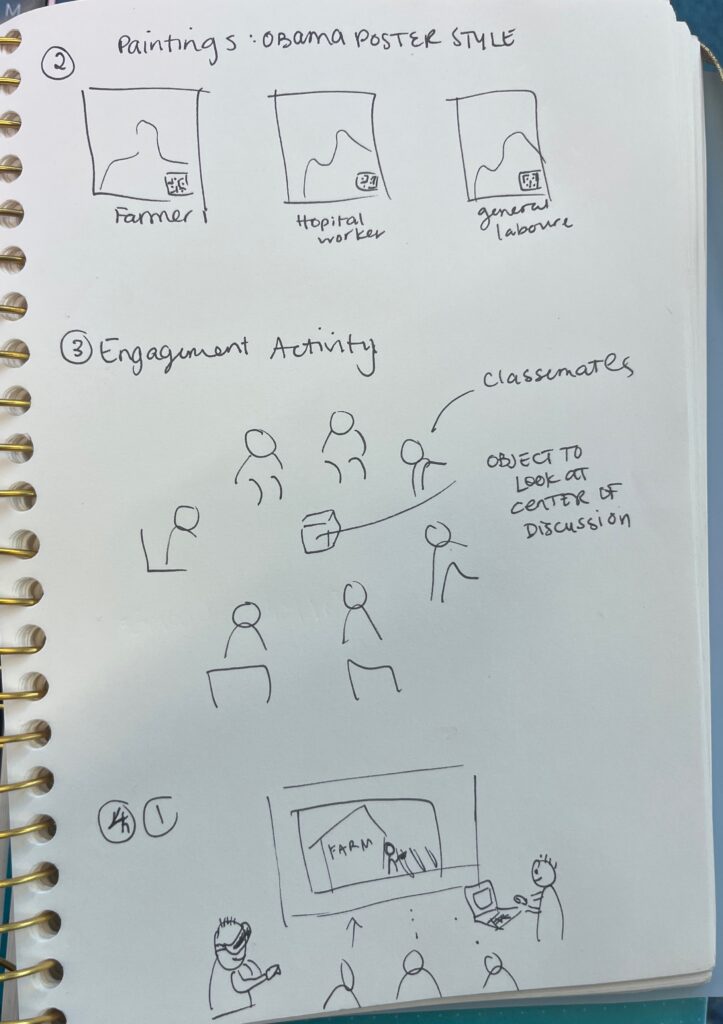
- IDEA 3: 3 Panel Artwork linked with QR Code: Create a 3 paintings that feature an Obama-style political poster art meaning to highlight the work of farm workers as the true heros of our time. Provide a QR code as a call to action and place to learn more. The intention is to highlight people who’s contribution is truly building up our country. Instead of featuring politicians, the poster highlights the every-day people who are critical for our way of life. This is a flip! Instead of propping up the already visible politicians, who in Canada are actually making life more challenging for every day people, we are propping up the invisible migrant population who are really behind the incredible services that make up our identity: farmers, hospital workers, neighbours, etc.

Artist Research – Shepard Fairey
- Where were they born? Where did they grow up? Where do they live now:
- Born Feb 15 1970, American, Fairey currently lives and works in Los Angeles, CA
- Founder of Obey Art Series
- middle-class teenager, Fairey had an interest in skateboard culture. By 1984 he was designing and selling hand-decorated boards and T-shirts.
- Where did they study art? Or are they self-taught?
- graduated from the Rhode Island School of Design in 1992 where he earned his Bachelor of Arts in illustration.
- What kind of art do they make?
- Graphic art; street art
- Looking at the one selected artwork
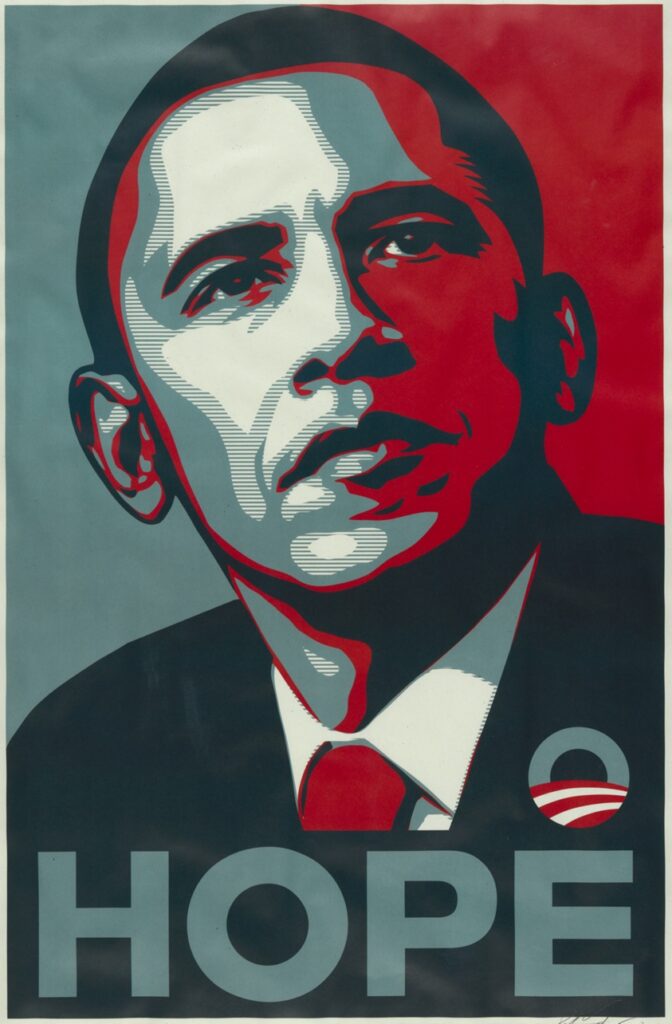
Barack Obama “Hope” Poster, 2009Shepard Fairey
Color lithograph on white wove paper
86 × 61 cm (36 × 24 in.)
- What are the formal aspects of their work (size, colour, materials, texture, value, composition, genre, style, etc)?
- based the work on an Associated Press photograph by Mannie Garcia,
- high-contrast stencil technique, inspired by the political message and bold graphics of Soviet Socialist Realism
- featuring reds and blues that complement the campaign logo designed by Sol Sender
- How do these formal aspects affect how you “read” the artwork?
- Idealized political propaganda style
- Patriotic colours
- Imagery of Obama “looking upwards” creates a sense of forward movement, possibility
- Iconographic style immortalizes Obama
- What materials and methods might she be using to make these works?
- I imagine it was created using a digital art tool which allowed Fairey to manipulate the colours of the image by Mannie Garcia.
- Then, it might have been printed or screen printed onto poster paper
- What is the context for this work (when this work was produced, what is going on politically, theoretically/philosophically, in the art world, in their personal life)?
- This artwork was produced as a tool for the Obama presidential campaign in 2008
- At the time, Obama would be the first black president in the history of the united states
- At this point Fairey was already well known for is “Andre the Giant has a posse” stickers and Obey line and had a developed style which he was using for political activism
- What emotions does the work elicit for you?
- Having the word “hope” right in the image does elicit the emotion
- Feelings of pride and patriotism
- The gaze and dress of the figure gives a feeling of: focused, determined, attentive, civilized
- What ideas does the work cultivate, or questions does the work ask you to consider?
- What is the imagery of a leader?
- What qualities doe we want to see in a leader?
- How does hope play a role in our selection of a presidential leader?
- How does emotion and imagery play into our selection of a presidential candidate?
- What does the artist say about their own work?
- “Art is not always meant to be decorative or soothing, in fact, it can create uncomfortable conversations and stimulate uncomfortable emotions”
- “I wanted strong. I wanted wise, but not intimidating,”
- …… What other questions about this artist or their work do you have?
- It’s interesting to note that Fairey was sued by the photographer for using this imagery. They were able to settle the dispute outside of court, but it did raise questions around copywrite law. This is something to keep in mind for my artwork as well.
- My question in relation to this, is if you buy a photographic image off of a platform like shutterstock, are you aloud to manipulate or alter the image and make money off of it? Or does this require a different kind of agreement?
- Is there anything about this artist’s work that interests you? What and why? If not, can you articulate why that is? What is missing for you?
- I like the simplicity of the artwork and it’s use as a political tool
- The use of a word to depict meaning and suggest emotion, which is especially useful in street art where an artist statement or artistic intention statement isn’t available
- I also like how quickly the artist was able to create this image. Being able to make art fast, especially for political statements, can be a great tool.
- Is there anything about this artist’s work that you can carry over into your own art practice? What in particular?
- This does inspire inspire me to learn how to use digital art platforms
- The use of colour to mimic politicial campaigns
- Include the links to the websites you obtained your research from.
- https://www.artnet.com/artists/shepard-fairey/
- https://www.artic.edu/artworks/229396/barack-obama-hope-poster
- https://www.artsy.net/artist-series/shepard-fairey-obey-barack-obama
- https://www.britannica.com/biography/Shepard-Fairey
Process
Stage 1: Creating the frame, measuring out the plywood peices, transfering images to plywood
After considering all my options an my timeline, I decided to go with the plywood box structure. To get started, I knew I needed to talk to Jeff since I had very little experience with capentry. I asked him if he could help me put together my box and he explained how to make the structure. Together, we measured and cut the wood. The measurements, as you likely know, are very important to get right. And at this point in my design I was still planning on doing all 3 sides of the structure with light coming from the imagery. Given the size of the wood we were using to make the structure, we had to leave space at the top and the bottom that would not have any cutting so that light could emerge from the full figure (not just 2 inches from the top and bottom of the figure).
We also considered adding wood in the corners to help with the structure, but ultimately decided that the piece could be held up by the plywood panels themselves, to avoid any further loss of the image due to obstruction from the wood.
After putting together the top and bottom frame of the box, I decided to work on the outline for the images. To save time, I used Nim’s projector and cast the images I’d selected onto the plywood surface. These two tasks took several hours to complete.
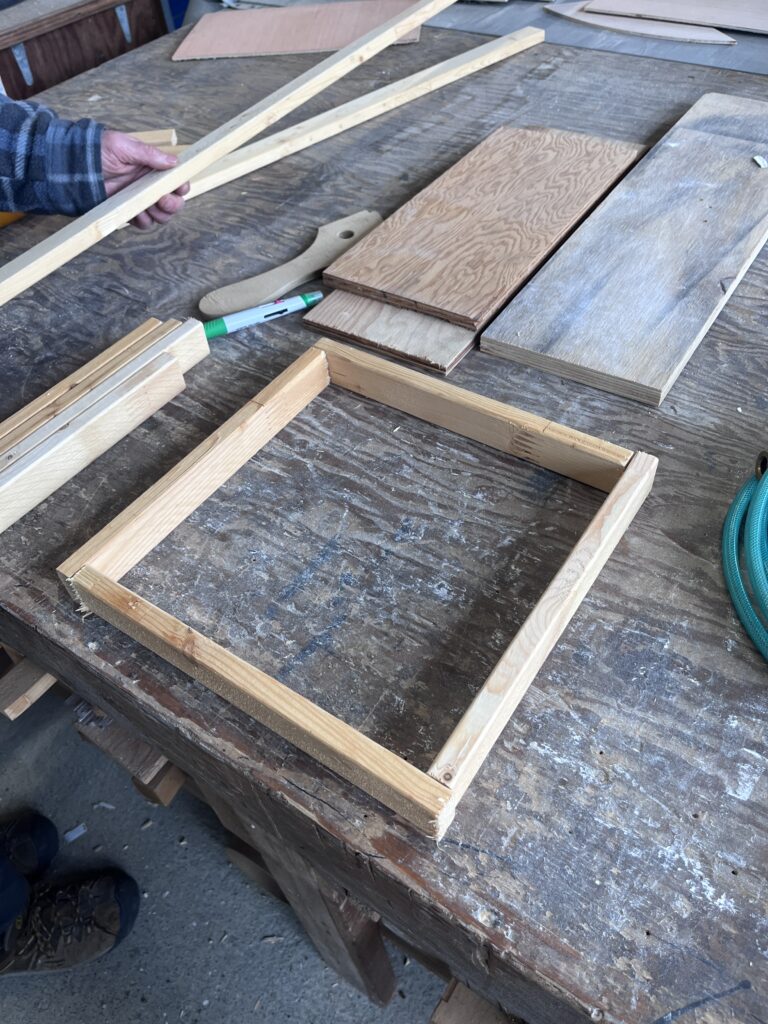
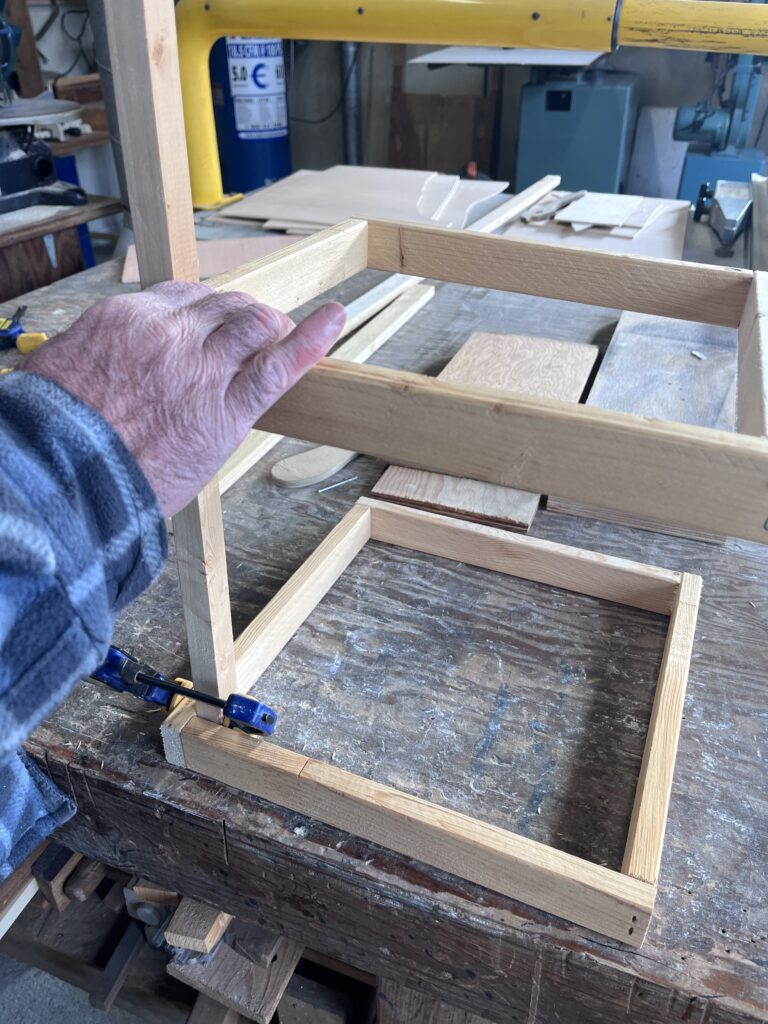
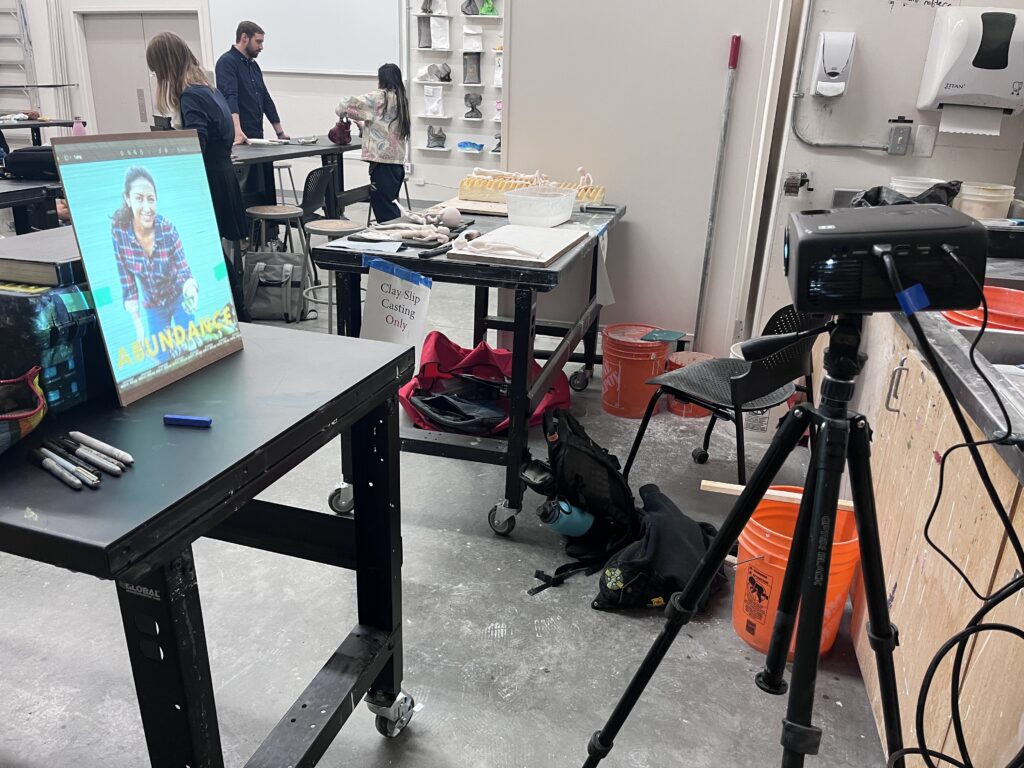
Stage 2: Testing cutting tools & scroll sawing the plywood
Althought I don’t have any image of my test plywood here, I can’t stress enough how important it was to test out my materials before going to cutting. Again, with wood and cutting, there really is no going back. So, I was fortunate to practice ahead of time with a spare piece of plywood. Here is where I learned that I wasn’t going to be able to use the engraving tip of a Dremmel tool. The engraving tool is made for, well engraving, not cutting through plywood and I quickly found out that the tool was entremely difficutle to maneuver and if I was going to try and cut all the way through the plywood so that light could come through, then I was going to get very thick and sloppy lines. That just wouldn’t do. So, I went to home depot to see if I could find any cutting attachments from the Dremmel. I bought two attachments and before the end of the night I returned them. The first was about an inch in size for cutting wood, and the other was 1/4 inch for cutting metal/diamond. Both of these ended up cutting the wood but the lines were too long, I just wouldn’t be able to cut the lines around the face or smaller details of the fingers. It wouldn’t do. So, I started investigating alternatives.
I considered getting it lazer cut, and contacted the MakeItZone. I knew my chances were slim given the short turn around time. So, I thought about moving to paper and using a cricut. But this would require at least a $50 investment and moving to paper. There is a cricut that can cut wood, but a vaneer wood not plywood, and these cricuts cost upwards of $450. I just wasn’t willing to fork that out. So, I considered the scroll saw, or just painting my panels and skipping the cutting all together. So, I emailed Jeff to see about the scroll saw and the next day I spoke to him about how to go about cutting with the scroll saw.
Jeff showed me how I could cut the lines of the figure without having to cut into the shape from the side of the plywood. This would require drilling small holes into each line, then detaching the blade of the scroll saw, placing the plywood, then reattaching the scroll saw blade for every single line. It would be labour intensive, but it worked and I got beautifully thin and maneuverable lines. I will admit, to detach and re-attach the blad of the scroll saw I needed to squat below the saw to pinch the blade on the bottom and this ended up giving me a heft work out. My legs were sore for days from squatting and standing so many times. Who knew I’d get a work out too!
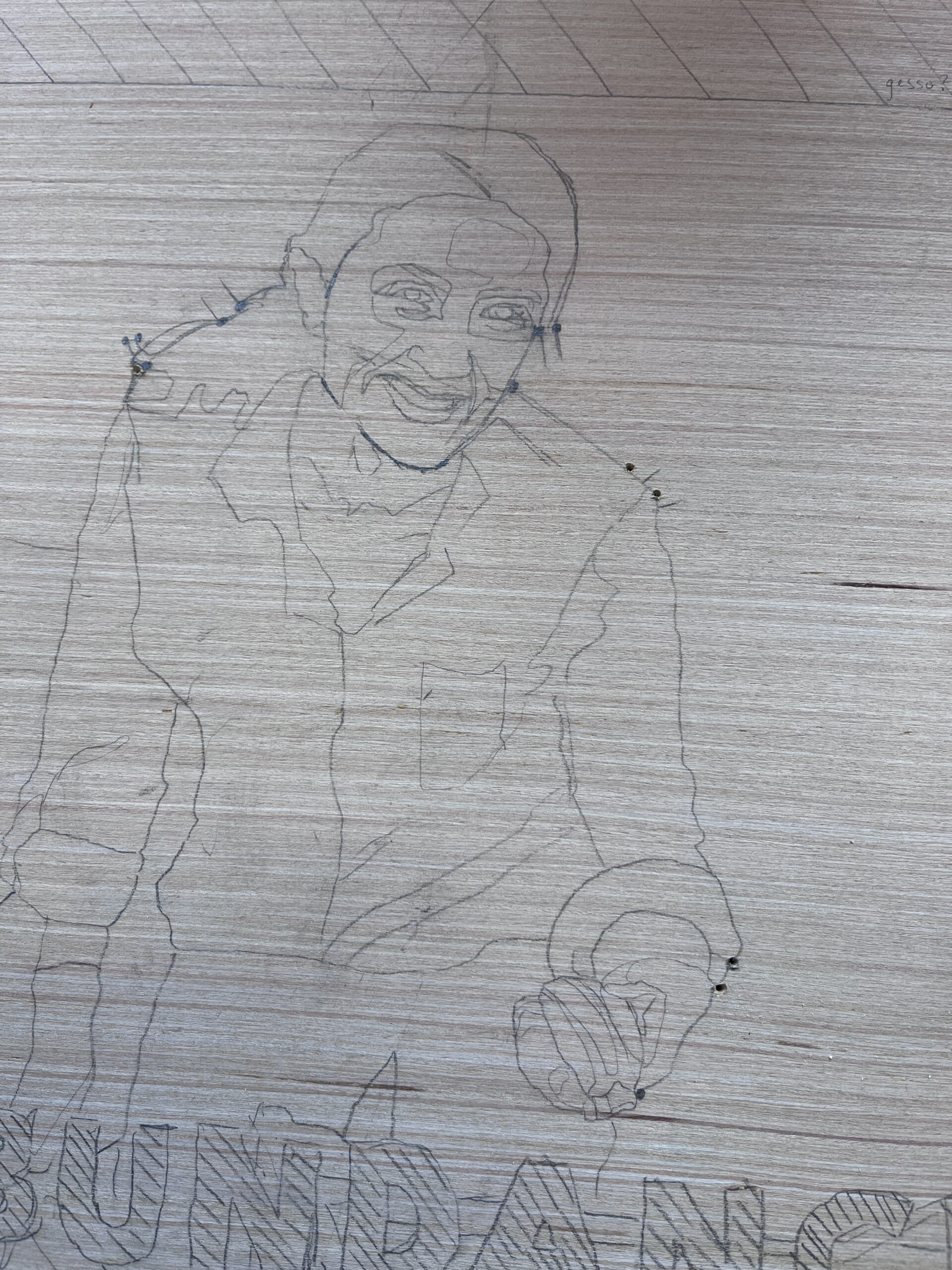
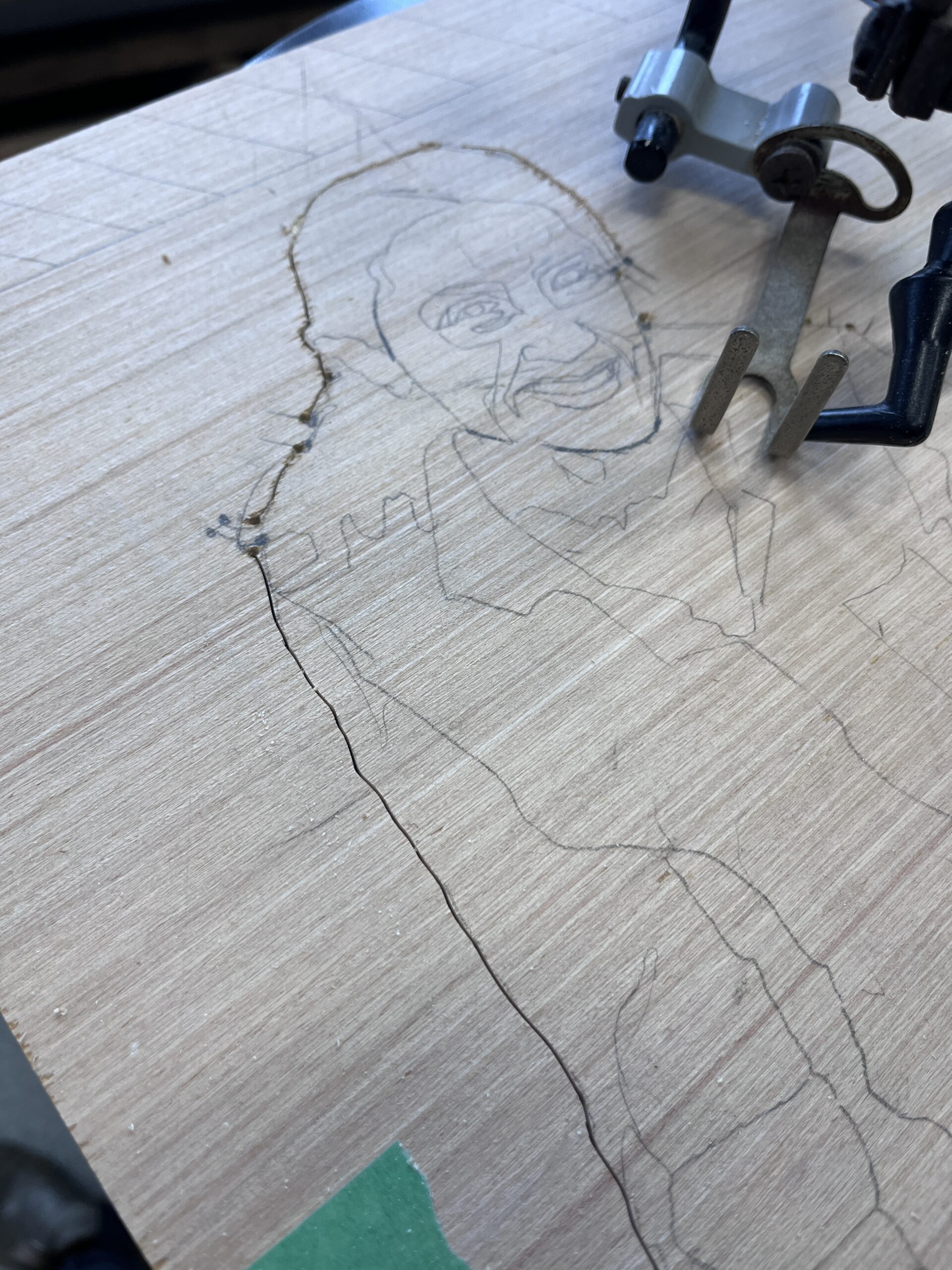
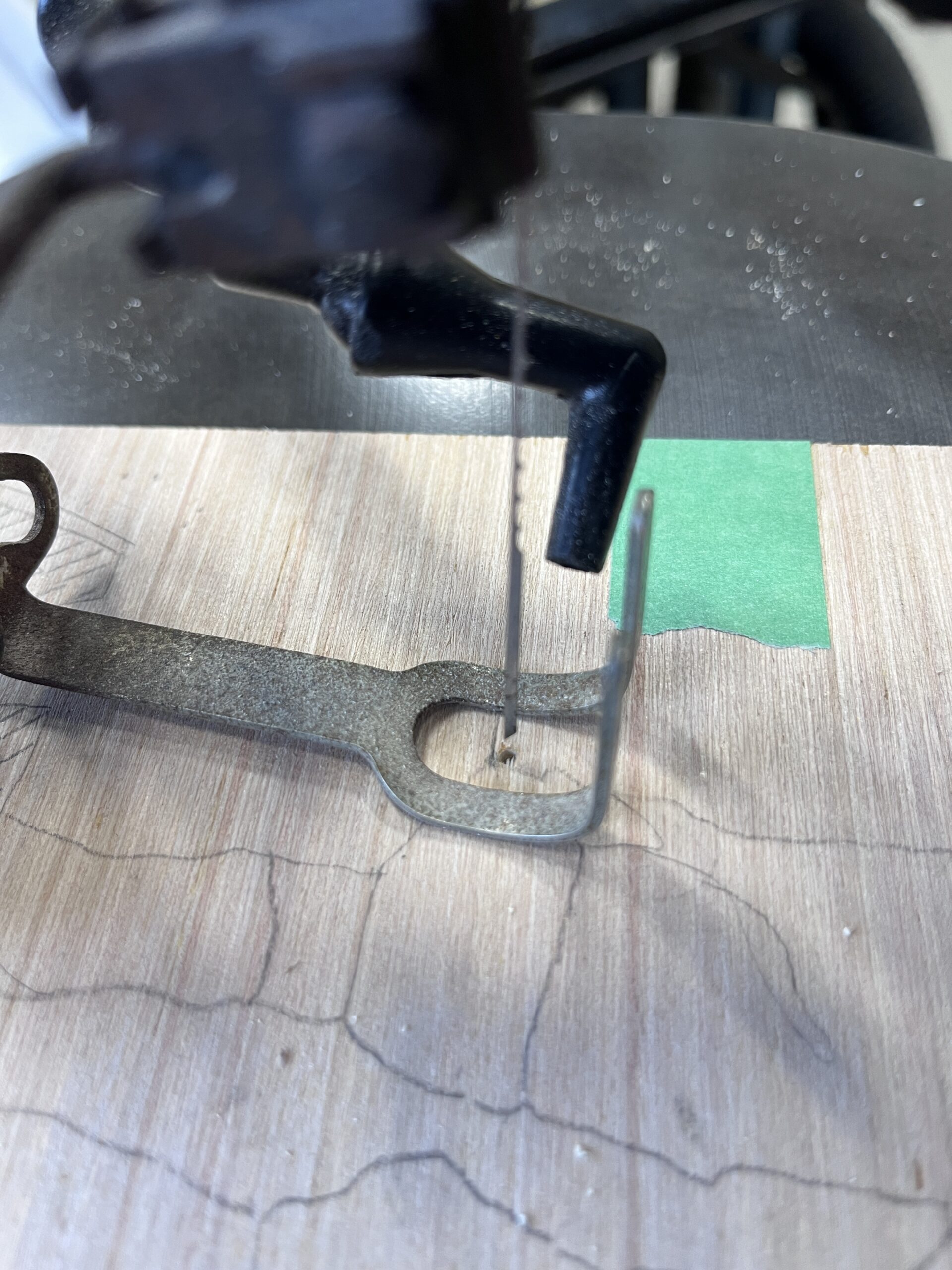
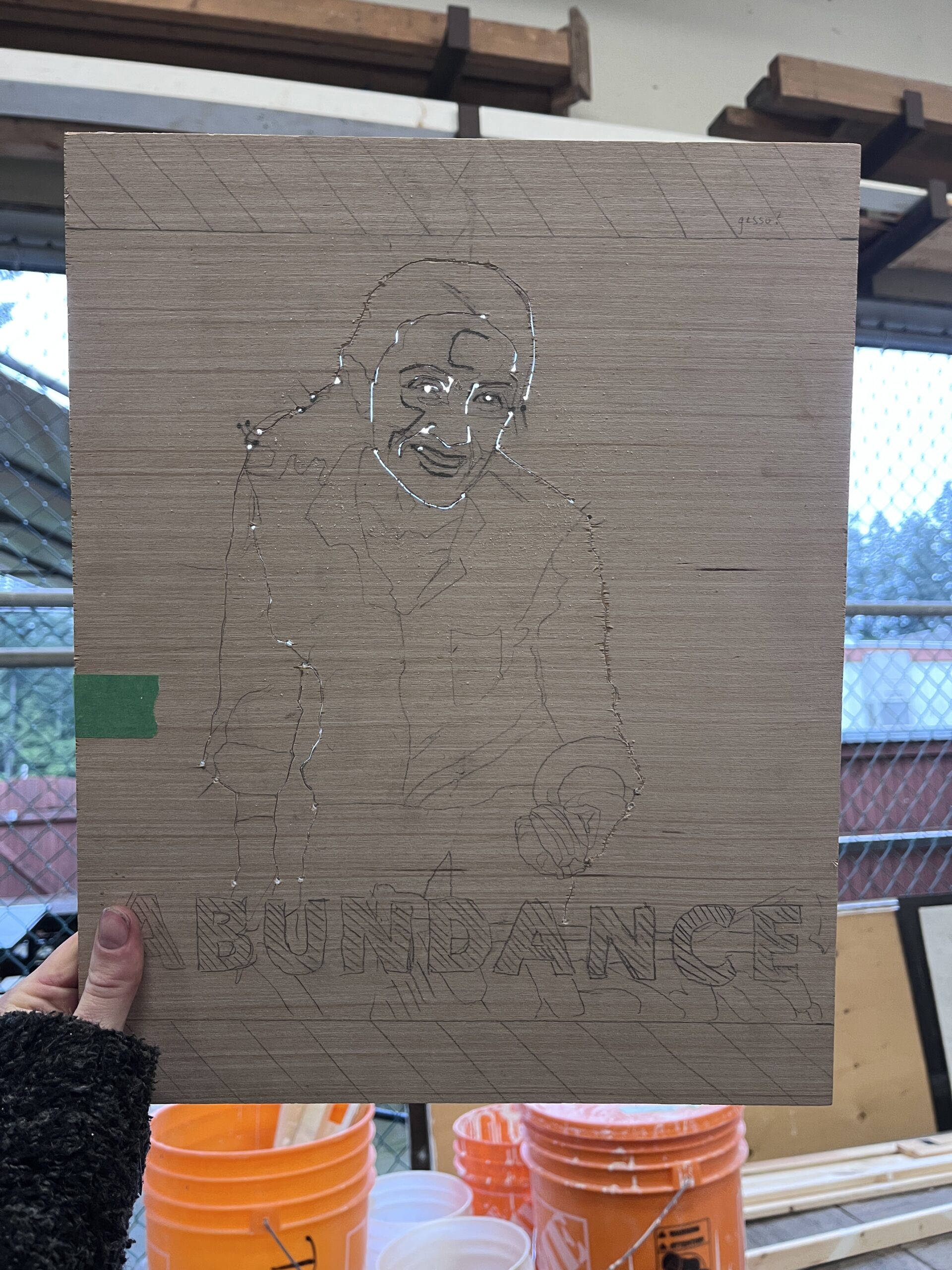
Stage 3: Painting the Plywood
Now that my plywood cutting was well on its way I had a more accurate depiction of how long this would take. Since I needed to detach and reatach the blade so many times, I knew I wasn’t going to be able to complete all 3 sides of the box. So, I decided I would paint two sides and only do one panel illuminated. I figured this might work out better because it would be hard to paint the cut edges without the paint getting into the cuts and preventing the light from coming through. In addition, the light coming through the lines might distort or prevent the colours from being seen on the panel. This way I could create the “obama like” poster while also getting at least one illuminated image.
I went ahead and prepped the plywood for painting with a clear gesso (pictured below). This was my first time using Gesso, and I realized later that once the gesso was down, I wouldn’t be able to erase any of the pencil line work below. That was a bit unfortunate because once I got to the painting there were a few edits I wanted to make. But I had to swallow those mistakes and go with what was drawn.
To decide on what colours to use I had my colour wheel handy. I wanted to go with an almost complimentary colour combo – eg. purple and orange, and green and purple, to really make the images pop. The Obama poster used blue/green and red so I wanted to use a similar complimentary scheme.
It was definitely difficult for my brain to translate value to colour schemes and I probably got some revered in areas. But I did alter the colours in the reference images to a “duotone” filter to help my eye determe which areas should be which colour. This definitely helped.
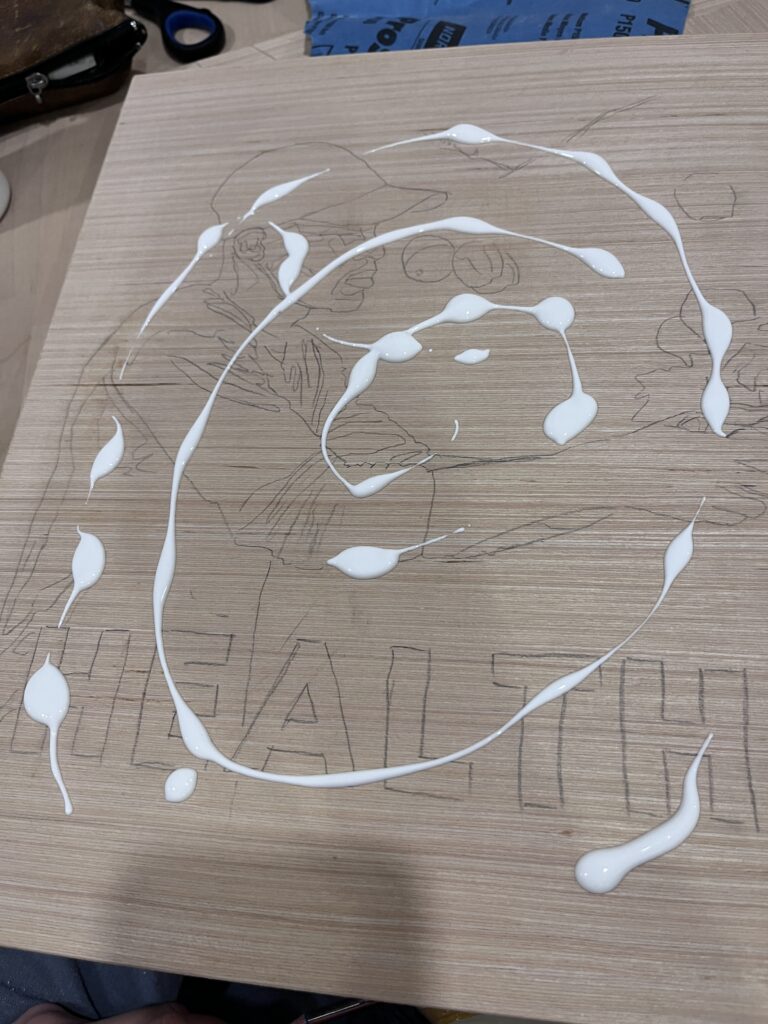
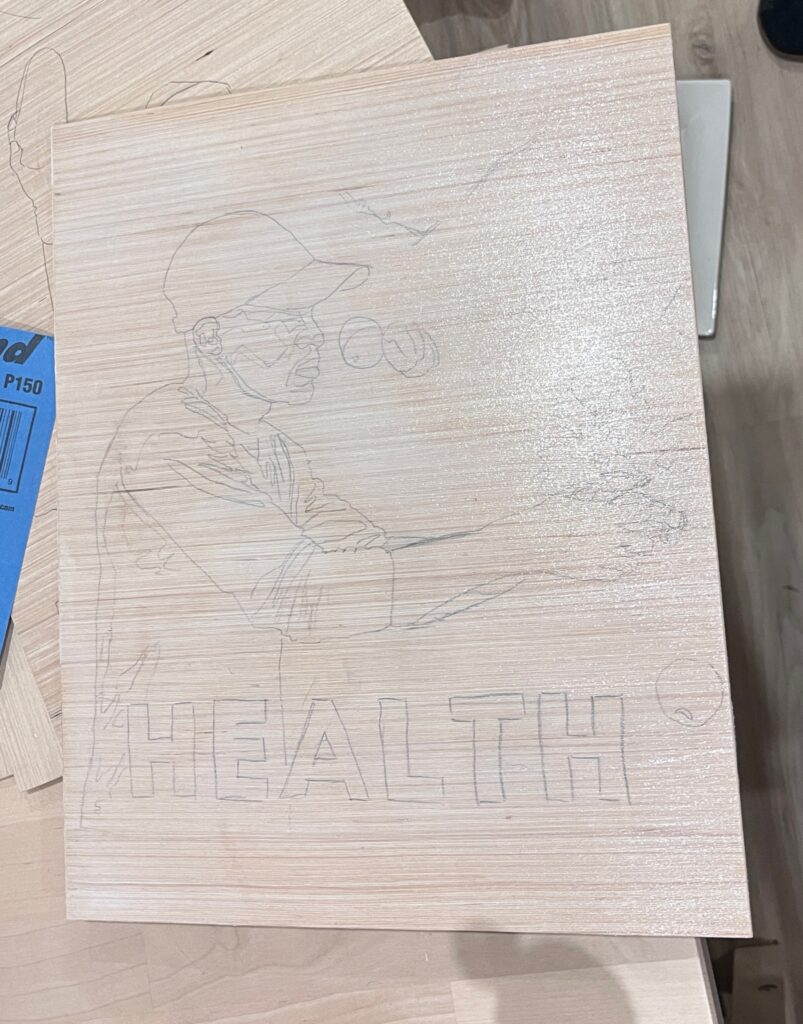
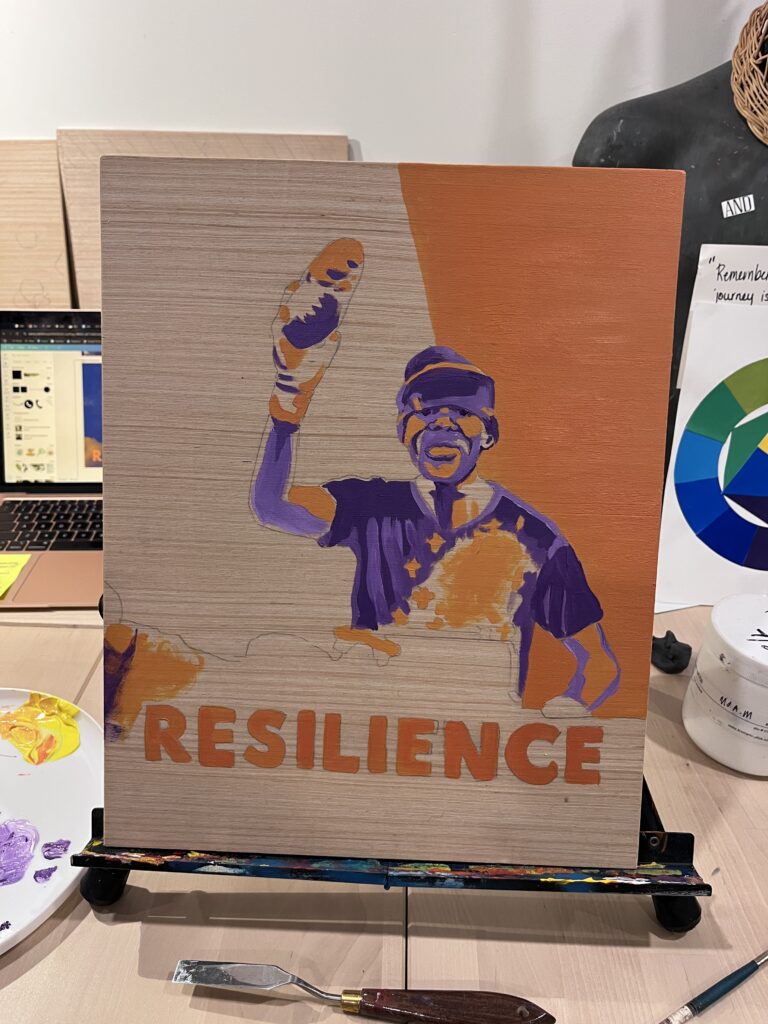
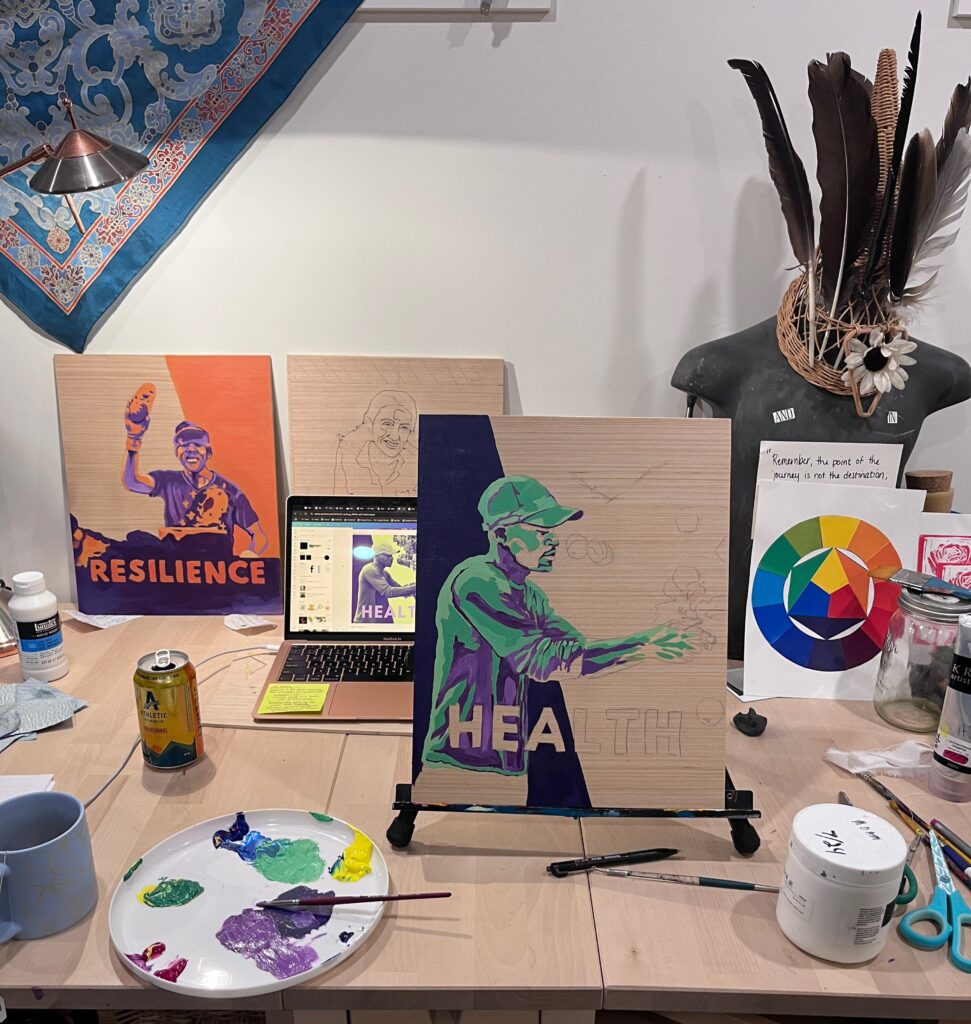
Final Artwork Documentation
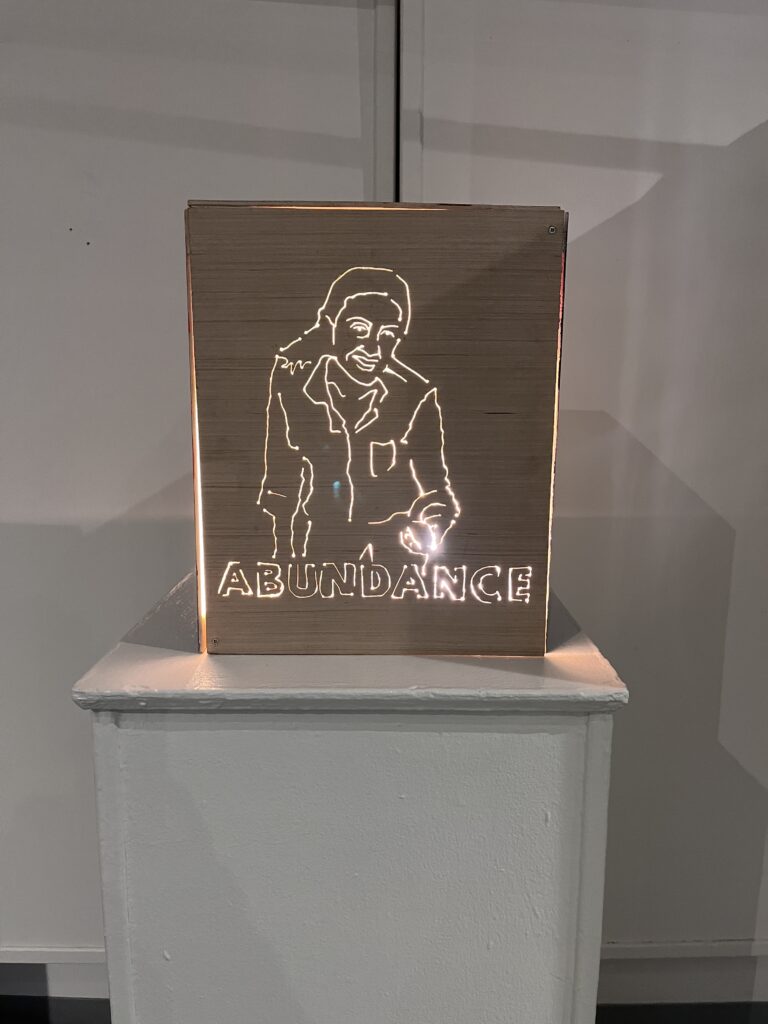
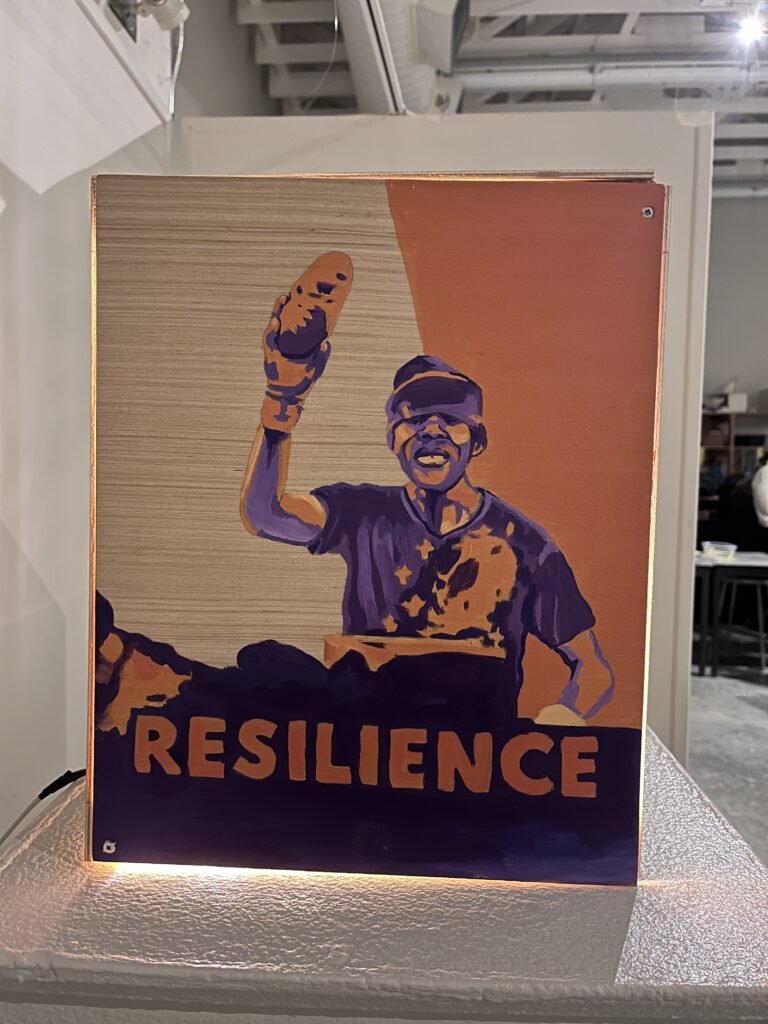
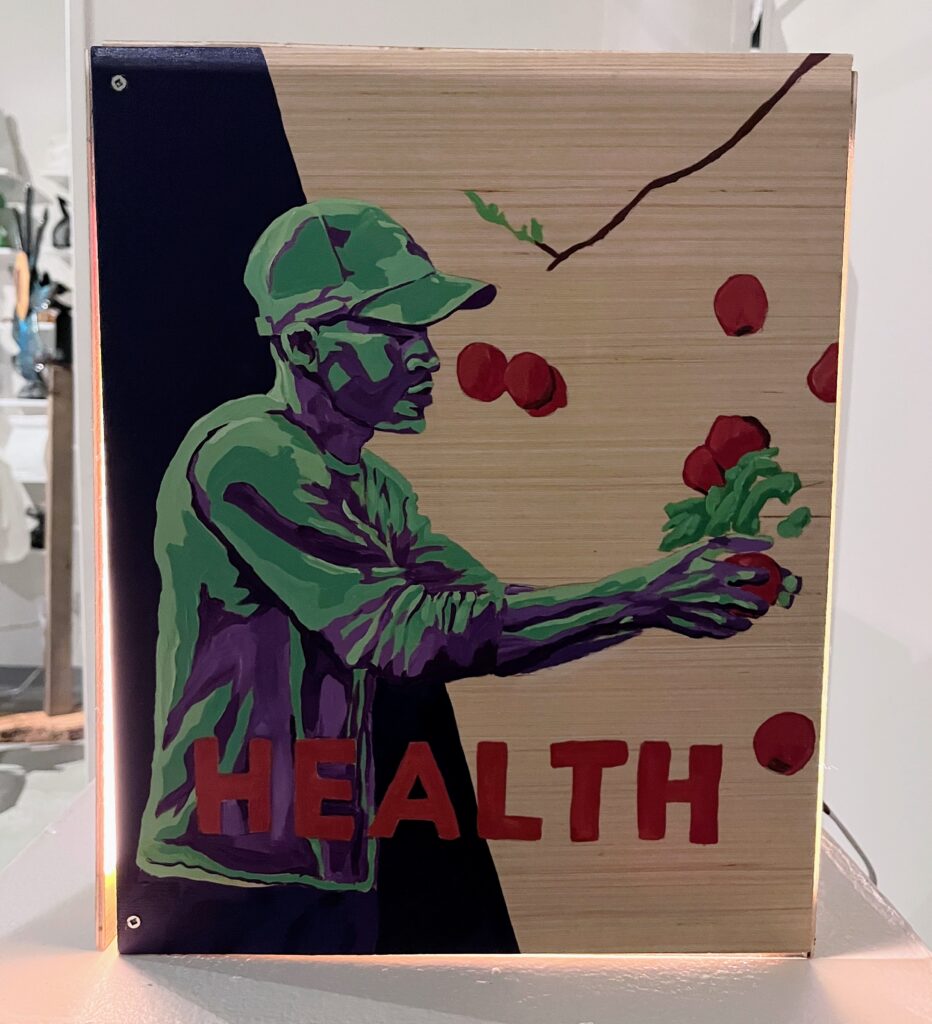
Truth Revealed
Arielle Houghton
Acrylic on Plywood, 2024
Intention Statement
The intention of this artwork is to show temporary foreign farm workers in a more positive light than what is currently being portrayed by the media and Trudeau Liberals. I wanted to celebrate the people who work so hard to put food on our tables. The work is made on plywood, with one panel cut with a scroll saw. The other two sides of the piece are painted in an “Obama Hope” style with acrylic. If I had more time I would have scroll sawed the images of the workers on all three sides of the plywood box to better illuminate all three images. To save time, I would like to explore utilizing a laser cutter from the MakeItSpace in Courtenay. Another consideration to explore is painting all three sides with the light illuminating the linework. However, I’d like to testing this with a simpler image first to see fi the light and colour would complement one another, or conflict by creating a poor quality back-lit image that is difficult to see.
Draft Artist Statement
Free write:
The artwork is about the way we put people in a box, and how behind those images, whether idealic or limiting, is the light from within the box, the true essence and offering of each individual. In particular this artwork focusing on the way we put migrant farmworking into this limitation of who and what they are. The burden they create in society and the way that we are to “deal” with that problem. Right now in Canada, the government is making drastic cuts to permanent residency and temporary foreign worker permits. While doing so the Liberals are blaming these workers for the housing crisis, inflation, and steep tuition costs. However changing work permits and further limiting access to permanent residency does not address any of these issues. Rather the political narrative is to scapegoat those often marginalized members of our society.
This artwork is the second iteration of an earlier work that attempted to draw attention to the recent UN Report on Contemporary forms of slavery, its causes and consequences by ____. The report revealed human rights infringements on temporary foreign workers among other populations in Canada and how the Canadian government can address these atrocities. In my earlier work I focused on the depiction of slavery as a bold attempt to move the viewer to act by signing a petition. In this iteration I wanted to focus more on the beauty of immigrants in Canada, honing in on farmer workers and they role in providing food to our society.
Each image depicts a farm worker harvesting a fruit or vegetable. Each piece is depicted on a piece of plywood and communicates a word which I chose in relation to the food being harvested. On one side, you see a farmer worker painting in acrylic holding up a potato with the word RESILIENCE. On the other side, also in acrylic, is a farmer harvesting apples. Here the word HEALTH is depicted. On the 3rd side of the plywood box is a farmer holding a Zucchini. Here we see the word abundance. But the 3rd farmer is not painting. Rather she is lit from behind and light escapes in lines which illuminate her form and the lettering. Light also escapes from the edges of the box, as if light is bursting from the seams.
In this way the work focusing on highlighting all that migrant farm workers offer: abundance, health and resilience to Canadian society. They are the light behind many of privileges afforded to those who live, eat, and grow in so-called Canada.
Artist Statement – Brainstorm
list of adjectives that describe your work.
- Illuminating
- Colourful
- Celebratory
- Proud
- Engaged
Emotions and reactions that you have to the work:
Hunger. Desire. Outrage. Positive Action. Hope. Pride. Gratitude. Expansion.
Write a casual letter to your best friend:
Dear Kelsey. Remember how I left you that super long voice message crying about how Canada treats migrant workers? Well, I decided that one art project wasn’ enough. This time I wanted to celebrate the incredible work of farm workers who make up the majority of temporary foreign workers, with hope to help people see just how important they are to our way of life. I spent a lot of time on the scroll saw trying to cut the lines of a form into plywood. So muchn so that my legs are sore from squatting so many times to detach and re-attached the blade of the scroll saw so as to separate each line on the plywood and prevent the whole image from falling out of the plywood background. Unfortunately this took so long that the other sides of the boxes are painting in an Obama-Style poster image featuring words like “hope” that I think capture the spirit of the farm workers: like “resilience, Health and abundance”. I’m pretty happy with how it turned out. Despite the short timeline. I hope you like it too!
Jeopardy your practice. What are the questions you hope to answer in your work?
- What is the value of temporary foreign workers?
- How to farm workers benefit Canadians?
- What foods do we have thanks to the labour of temporary foreign workers?
- What do you wish people would see about farm workers?
WHAT – WHY – HOW STRUCTURE
- WHAT – The Key Idea: a sentence about what you are doing – don’t keep the reader in suspense!: In this plywood box-shaped structure, farm workers are depicted offering the fruits of their labour; the foods we eat. On one side the view sees a working holding a zucchini and the word abundance, on another side a potatoes and the word resilience and finally apples and the word health. The farms are scene in an
- WHY – the context for the work, and/or the initial inspiration. This information should help explain why you create your work: The work is intended to case a light on all that temporary foreign workers and migrants offer Canadian society. The piece focused on farm workers, who make up the majority of temporary foreign workers. Currently the common political rhetoric is that migrants are the cause of contemporary issues such as the housing crisis, the high cost of education, and job shortages. This work attempts to offer an alternative view and illuminate the fruits of migrant labour.
- HOW – research: For my research on this piece I reached out to local migrant rights networks, read the 2024 Report from the United Nations on Contemporary Forms of Slavery it’s causes and consequences which highlighted the issues being faced by Temporary Foreign workers in Canada. In addition, I researched about the recent changes to immigration policy by the Canadian Government under the Trudeau Liberals. Finally, I wanted to look deeper into the history of the struggle of farm workers in North America, so I also researched information on the Farm Workers movement in the USA (and Canada)?
- CONCLUDING SENTENCE: This work aims to illuminate the true heroes behind a Canada we know and love – the farm workers who put food on our table.
Artist Statement
In this plywood box-shaped artwork, farm workers are depicted offering the fruits of their labour; the foods we eat. The work is intended to illuminate the benefit of migrant workers in Canada. In particular, the piece focused on highlighting farm workers, who make up the majority of temporary foreign workers.
The current rhetoric in Canada is dominated by the narrative that migrants are the cause of contemporary issues such as the housing crisis, high cost of post-secondary education, and job shortages. This work attempts to offer an alternative view; it is Canada who is exploiting migrants. It does so by reflected those workers in the same style as the political propaganda imagery used during the 2008 election created by artist Shepard Fairey depicting Obama with the word “hope” written below. In doing so, the viewer sees migrant workers in a positive light, similar to how politicians are idealized in during election campaigns.
This artwork is inherently political and was inspired by recent media on the UN Report which exposes Canada for its role in creating contemporary forms of slavery. I was inspired by this report and it’s offering of a buffet of solutions to the abuse of migrant workers. Drawing from my own experience as a community organizer, my organizing practice largely comes from the Farm Workers, Civil Rights and Labour Movements in the USA which was studied and packaged as an educational tool by Harvard Professor Marshall Ganz. In addition to drawing from my personal experience, I researched local migrant networks and organization offering more information on the recent changes to immigration policy by the Canadian Government
This work aims to shed light on the true heroes behind the Canada we know and love – a place where people of all backgrounds can come together and enjoy the abundance of the land around good food.
FIN 140 Unit 2
Lab 1 – A Walk
- Place: Canada, K’omoks Territory, Ryan St. Campus Forest, North Island College
- A train in the woods, a forest habitat with wind blowing throguh the trees and birds chirping.
- Relative ease and natural soothing landscape
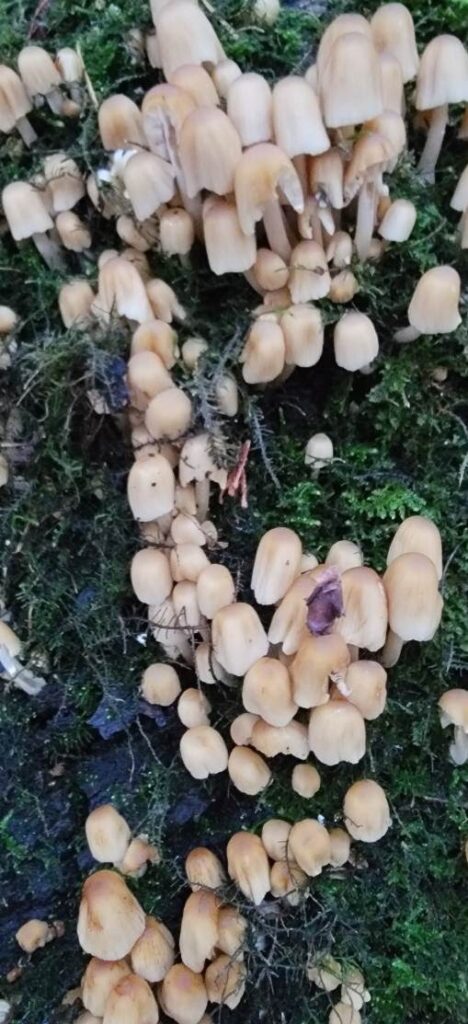
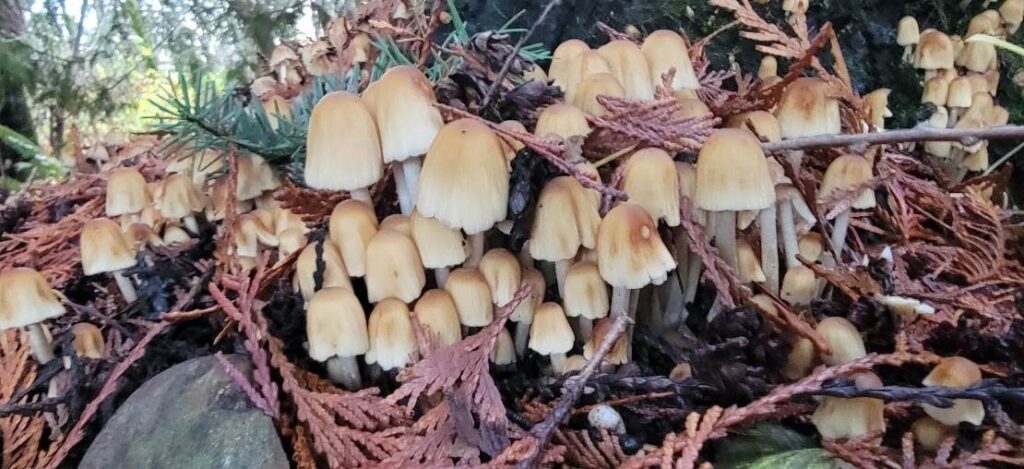
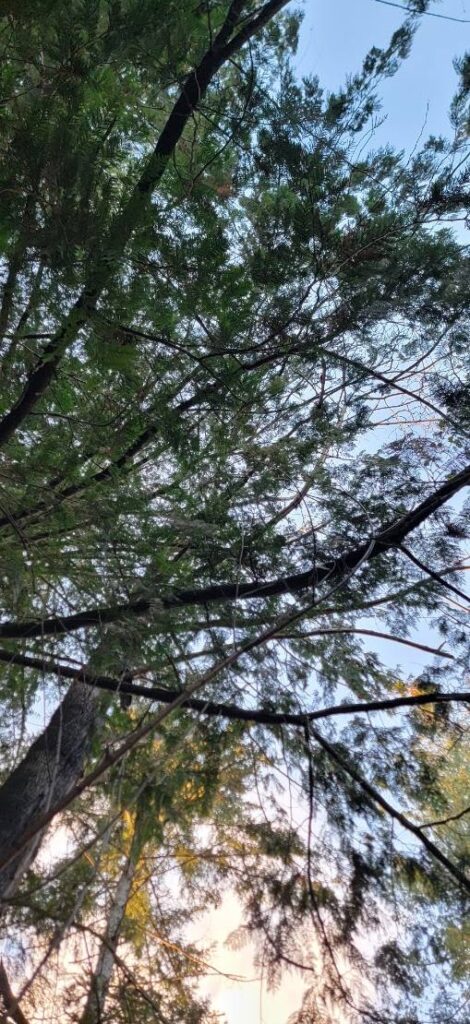
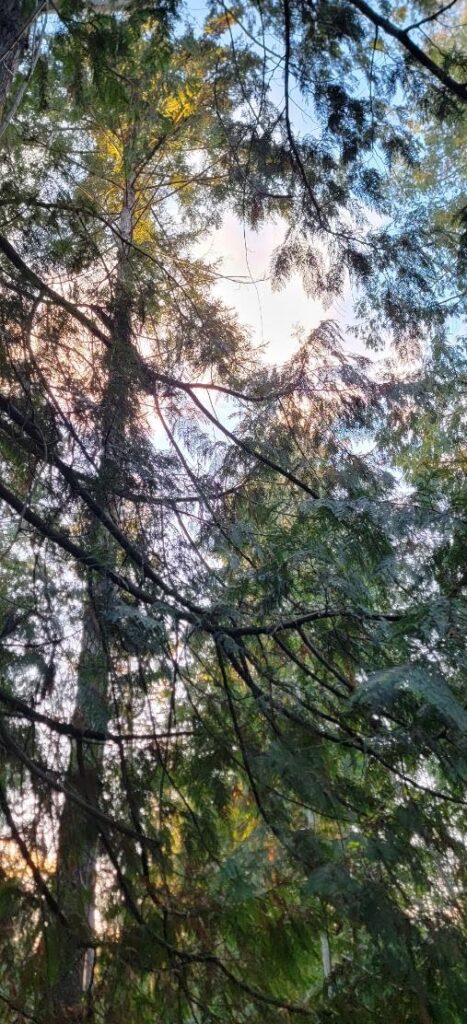
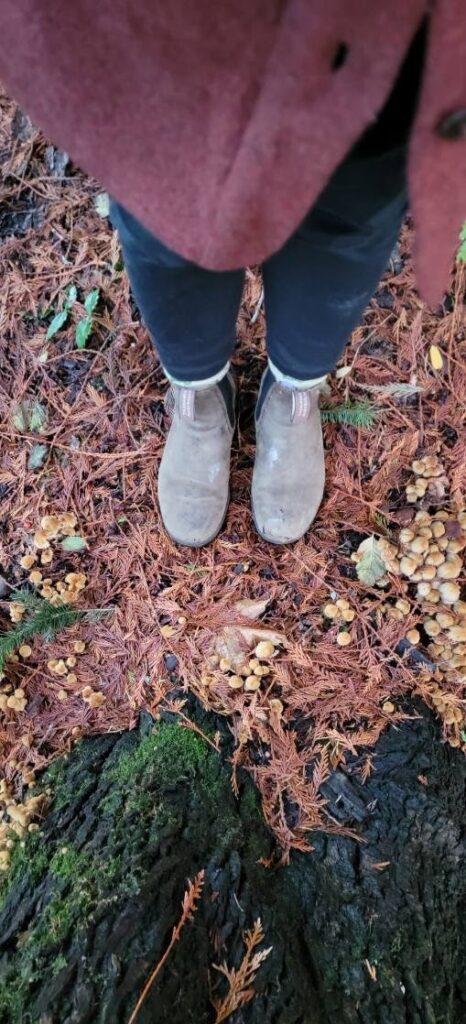
3. Touch
- Tree Bark: Rough and cold, what stories you may hold, with textures deep, your grooves surely haunt me in my sleep
- Moss: Fluff and warmth, how varied you are, lining on the edge of an elephant’s truck, like a carpet upon the dark
- Cool breek cuts deep, shivers reflect both sense and spirituality, here I feel my truth, surrounded by my roots
4.
- Colour green light and dark fluxuates like my heart. In and out, soft on rough, but nothing smooth but a chopped of limb.
- Brittle of bark – fresh of green
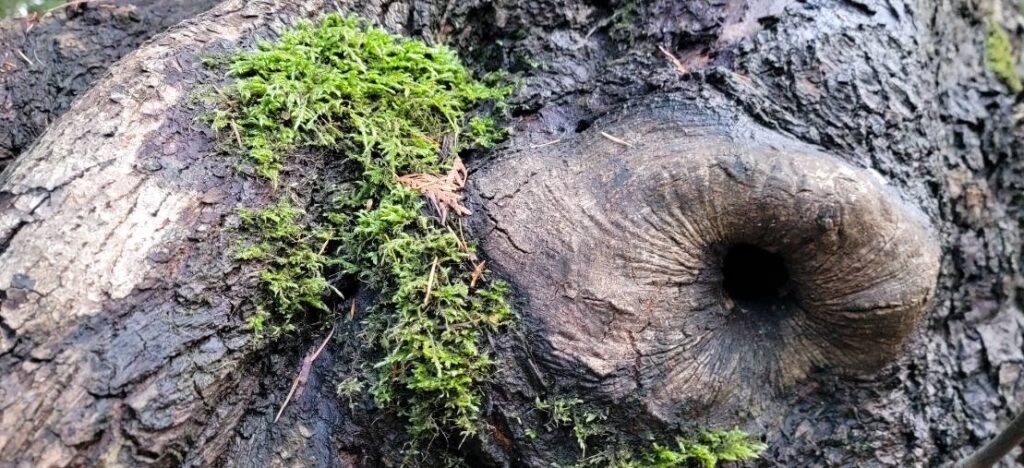
5. Hear
- Wind
- Engine
- Bird chirp
- Branches rustle
- Crack and thud
- Wind swirling
- Breath
- Ballpoint pen
- Wooshing wind
- Engry engines
- Busy birds
- restless branches
- violent cracks
- dancing winds
- rhythmic breath
- scratching pen
Rythmic Breath

- up and down
- in and out
- cold and warm
- broken rhythm
- Continuous
6. Smell
- Dog dandruff mixed with decaying leaves
- Earth and comforting, like renewal.
7. Action
- Brittle and acidic, crunchy and cold, chewing chewing, getting old. Swallow deep, get it down, medicine, I’m sure to frown.
Lab 2 – Partida for Eight Voices
The piece started out very chaotic. The volume was loud and the unharmonized voices was overwhelming. The speaking coming from seemingly all directions was reminiscent of the “monkey mind”. In other worlds, it felt like there was so much busy speaking and voices talking over one another I could barely make out what anyone was saying. It reminded my of how I feel when I’m unaligned. Yet, I did happen to capture that they all seemed to be talking about mathematics equations. Then, as the piece progressed they manage to speak more and more in synchronistic, eventually erupting into harmonious song that was very pleasing to the ear. It reminded me of religious choir music. It felt elevating. The contrast of the chaos with the harmony made the piece feel more impactful. The voices did speak again but when they did they were speaking about the same thing and eventually speaking at the same time. Finally they returned to song and I was lulled back into the soothing euphony. It felt like a massage for the brain.
Music I suggest for concentrated listening include the following two pieces:
- Once it’s all on the ground – by Lake Mary, Paul Dehaven, and Jordan Knecht: https://open.spotify.com/track/53CkZJnv3UiTyKrU27isAx?si=ae1241f6816a43ff
- The Beauty of Sorrow – by Pauline Oliveros: https://open.spotify.com/track/078txIRiyvxbjjYesA9qy6?si=779b7dae36a246d0
Feedback to Zoe Pigot:
https://open.spotify.com/track/1SlaYIznNpoMqq407EL9NR?si=jeuUB4grQVe-X3vzpDKCkA
Hi Zoe! Thanks for sharing your music. I listened to me and jesse [part one] and found it… well, surprisingly stressful. Maybe it’s just the state that I’m in and I’m projecting, but I felt this constant rush throughout the whole song. While the softer plunking notes did add moments of a lighter excitement, the pace of the song made me feel rushed! Maybe that’s the excitement that is being created in others and I’m reading it in my body as anxiety. It’s interested how anxiety and excitement are such similar feelings in the body. I wonder how much of the distinction between the two emotions falls to choice.
Feedback to Aaron Brenner: Ben Howard – Promise
Thanks for sharing these artists Aaron! I listened to Ben Howard’s Promise, and while I’ve heard it before, the intentional listen brought up some new feelings towards it for me. I found the static sounds at the beginning to be very interesting. I noticed the other song you recommended by Flight Facilities does a similar thing and I wonder if this is sort of like a “hook” for audio artists to start to generate interest from the listeners. The rest of the song was also beautiful, I’ll admit! It made me think of my kitty. Like who am I to deserve such a sweet unconditional love! hehehe. I also noticed that the steady vibrational hum that was happening in the background of the song made the composition feel really “full”. I’m not sure how else to describe it, but it’s something I noticed while listening to Benj Rowland play the Hurdy Gurdy too. It feels comforting, like I’m being wrapped in warm blanket.
Check out Ben Rowland playing the Hurdy Gurdy here: https://open.spotify.com/track/45Cenag2nhM5MZKftdYHM5?
Video Edit Practice
Video editing practice: https://youtu.be/bKFNK0yt24I
Artist Research – Yoko Ono
- Where were they born? Where did they grow up? Where do they live now
- Japan, 1933
- she moved with her family to New York in the mid-1950s and enrolled at Sarah Lawrence College. Over the next decade she lived in New York, Tokyo, and London, greatly influencing the international development of Fluxus and Conceptual art.
- At Sarah Lawrence College in Bronxville New York she studied writing and msusic
- Currently living on a rural farm in upstate new york after living in NYC for 50 years
- Ono was born into a banking family who suffered from starvation during World War II. They were often forced to barter household items for food while they sought refuge from Allied bombing raids.
- Where did they study art? Or are they self-taught?
- At Sarah Lawrence College in Bronxville New York she studied writing and msusic
- In 1952 Ono became the first woman admitted to the philosophy program at Gakushūin University in Tokyo, but, after about a year there, she joined her family in the New York City area, where her father, a bank executive, had been transferred.
- What kind of art do they make?
- Conceptual and performance events
- Many of the works she created during this time existed primarily as written instructions for others to carry out or, in some cases, merely to muse upon. Ono later compiled these epigrammatic texts—Lighting Piece (1955) offered the direction “Light a match and watch till it goes out”—in the book Grapefruit (1964). Interested in the integration of art with everyday life, Ono became associated with the Fluxus collective, and in 1961 the group’s founder, George Maciunas, provided her with her first solo gallery show.
What are the formal aspects of their work (colour, pacing, composition, genre, style, etc)?
- In a performance hall space of the Louisiana Museum several men walk into the room with an object bundled in a black sheet. They place the sheet in the centre of the stage and reveal what it is by pulling back the folds to expose primarily off-white and colour speckled ceramic pieces. At this point, Yoko Ono walks onto the stage and take a microphone where she proceeds to make loud noises. She screams and yells and makes varying sounds into the microphone for about 40 seconds (13:22 – 14:01). She immediately proceeds to say “I just wanted to clear the air” to which the crowd errupts in laughter and applause.
- In the background the words written in Japanese from her previous performance drip in black ink on what appears to be 8 foot tall canvas panels. In her previous act she shares a story of her life and culture and explains what the words she has written says to the audience, “Give us 7 happiness and 8 treasure, pray for you.”
- She introduces the piece sharing the name, “this is called promise piece, and well there are a few promise pieces, but this is one.” She explains that the broken pieces of ceramic on the black fabric on the floor were exactly like “this” and she points to a large vase that stands almost as tall as her waist. The vase is white with blue and pink. It’s difficult to see the markings on the vase, so I’m assuming the imagery on the vase is not of impotance to the piece. She explains that now the vase is destroyed. She says that she would like “you” (members of the audience) to take one piece each, “and in 10 years we meet again and put it back together again into what it was.” She says thank you and exits from the stage.
- The darkness of the silhouetted audience mirrors the dark writing on the back of the stage
- The warm lighting on the stage makes the space seem inviting and welcoming.
How do these formal aspects affect how you “read” the artwork?
- Yoko has taken a formal space (a museum) that is normally reserved for history and art and little more engagement from the audience than viewing ancient pieces, and created an informal welcoming space where people can come on stage, touch, and even bring home pieces of the experience. But there is a responsibility that comes with taking a piece – a commitment to action by returning in 10 years and engaging in the difficult task of putting together a broken vase. She uses humour and personal storytelling and an inviting challenge to engage her audience. Her bravery of sharing a vulnerable story in her previous act, feeds into the broken pieces performance setting the stage for her next courageous act: yelling seemingly relieving sounds into the microphone. Her performance demonstrates trust to the audience – her faith that they will meet again and continue to be a part of each others lives. In this way she gives not only a physical a gift but the gift of belief in her audience.
What is the imagery explore?
- The power of belief, an expression of faith, and the generation of good energy
- What is the context for this work (can you make a connection politically, theoretically/philosophically, in the art world, in their personal life)?
- There were three acts in this show, the first of which was Ono’s legendary performance “sky piece to jesus christ” followed by her “action piece” painting, clearing the air scream, and then the “promise piece”
- She mentioned this is not the only Promise Piece. In fact this performance has been going on since 1989. In this way Yoko Ono is making connections with potentially thousands of her audience members from around the world: 1966 London, 1989 Paris, 2009 Venice, 2014 Florida and more. Normally Yoko destroys the pot on stage but for this performance it was already broken.
- Yoko shares that her life is full of difficult experiences. Her early life includes experiencing hunger and near starvation during the second world war as a child. she moved to the states during a time where there was likely a lot of racism towards Japanese people. The piece is likely an invitation for all viewers to become active participants at reconstructing the beautiful but fragile vase. Perhaps the vase is a symbol of holding – whether water, nature or one another. The vase is a cultural object and has had important ceremonial purposes in cultures (i.e. ancient greece among others). Perhaps this is an invitation to reconstruct, together, a culture that has been broken and shattered.
What ideas does the work cultivate, or questions does the work ask you to consider?
- How will they know how to put it back together?
- When and where will they all return to put the pot back together?
- Will Yoko Ono facilitate the audience putting the pot back together?
- Does she really believe people will come together to put it back together?
- What is the value of trust and belief?
- How is she building connections with her audience? Do they trust her as much as she trusts them?
- What does the audience think/believe about the piece?
What emotions does the work elicit for you?
- Curiosity, doubt, worry, hope
What does the artist say about their own work?
- “All my works are forms of wishing”
Is there anything about this artist’s work that interests you? What and why? If not, can you articulate why that is? What is missing for you?
- I am drawn to the artist and her work for several reasons: 1) it’s political 2) it’s personal 3) It’s engaging and encourages audience participation 4) it’s open enough for the audience to walk away reflecting on the deeper meaning.
- Finally, I have to say, that when I was experiencing some of the most difficult times in my life, it felt like all I wanted to do was scream as loud as and honestly as I could. But I didn’t have the courage to do so. I didn’t feel safe enough to do so. But Yoko did. She still does. She’s still screaming into microphones in front of rooms full of people and for that, she’s a bloody inspiration.
Is there anything about this artist’s work that you can carry over into your own art practice? What in particular?
- Oh man. This is so deep and fascinating and inspiring! It truly makes me want to engage the audience more in my artwork. How can I empower my audience and leave them feeling deeply connected to one another? I think I could ask myself that question for every piece that I make.
Include the links to the websites you obtained your research from:
- https://www.pbs.org/newshour/arts/burn-story-yoko-ono-youve-read
- https://www.moma.org/artists/4410
- https://nypost.com/2023/02/24/yoko-ono-leaves-nyc-for-a-farm-she-bought-with-john-lennon/
- https://www.britannica.com/biography/Yoko-Ono
- https://www.xibtmagazine.com/2022/01/ekphrasis-the-self-curated-film-performance-art-of-yoko-ono/
- https://www.youtube.com/watch?v=-PZqi1oPXHk&t=783s
- https://www.fondazionebonotto.org/en/collection/fluxus/onoyoko/4/1292.html
Video Poem Brainstorm
What is the concept I want to communicate?
- Cancel Culture?
- Shame – speaking shame
- Freedom through expression
- (IFS) parts of self
| Haiku | Image brainstorm |
| So light, delicatebut under it’s weight trees crackRoofs collapse. Hearts failAuthor unknown | a leaf fallingtree branches moving in the windWater rushing in the riverhand reaching out from the waterglass shattering |
| I did, I admit Fell victim to my weakness Fear, alone, shame, shame Arielle Houghton | Signed documentfalling to kneesholding onselfLooking downwardsthen looking upwards to the light |
| But nothing could kill a faith like a guillotine, as heavy, as light. By Rachel Wetzsteon | lights coming through the trees of the foresteyes closingdropping a flashlight in the darkknife cutting a carrotA door closing |
I did, I admit
Fall victim to condition
Part of me, not true
Arielle Houghton
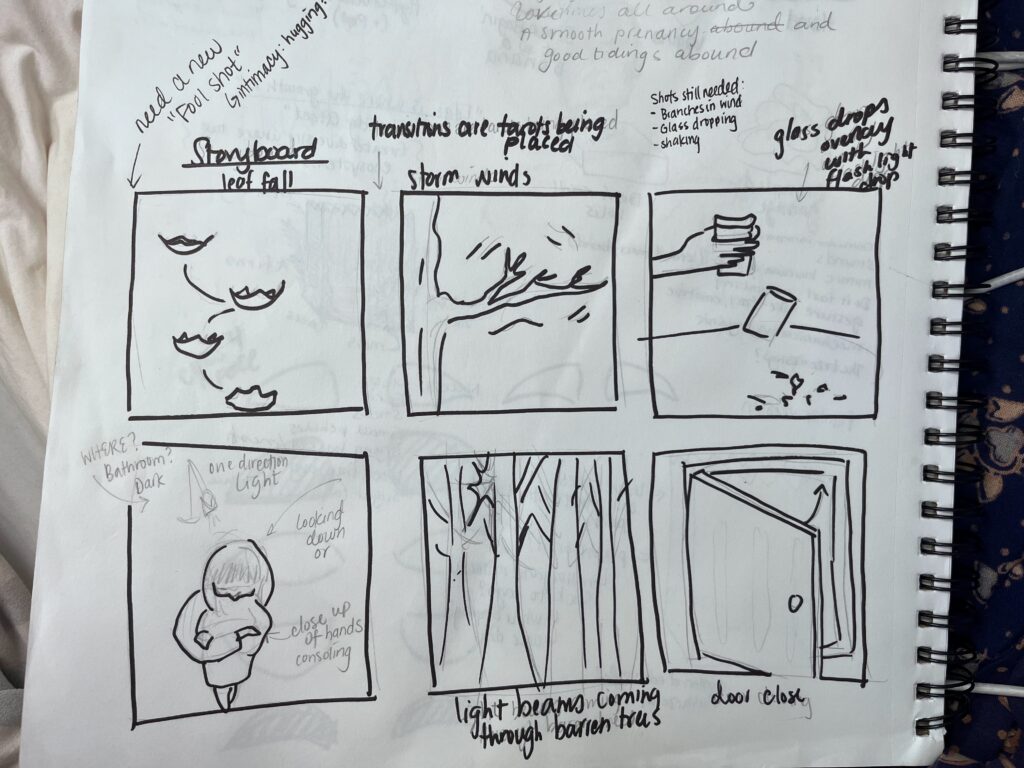
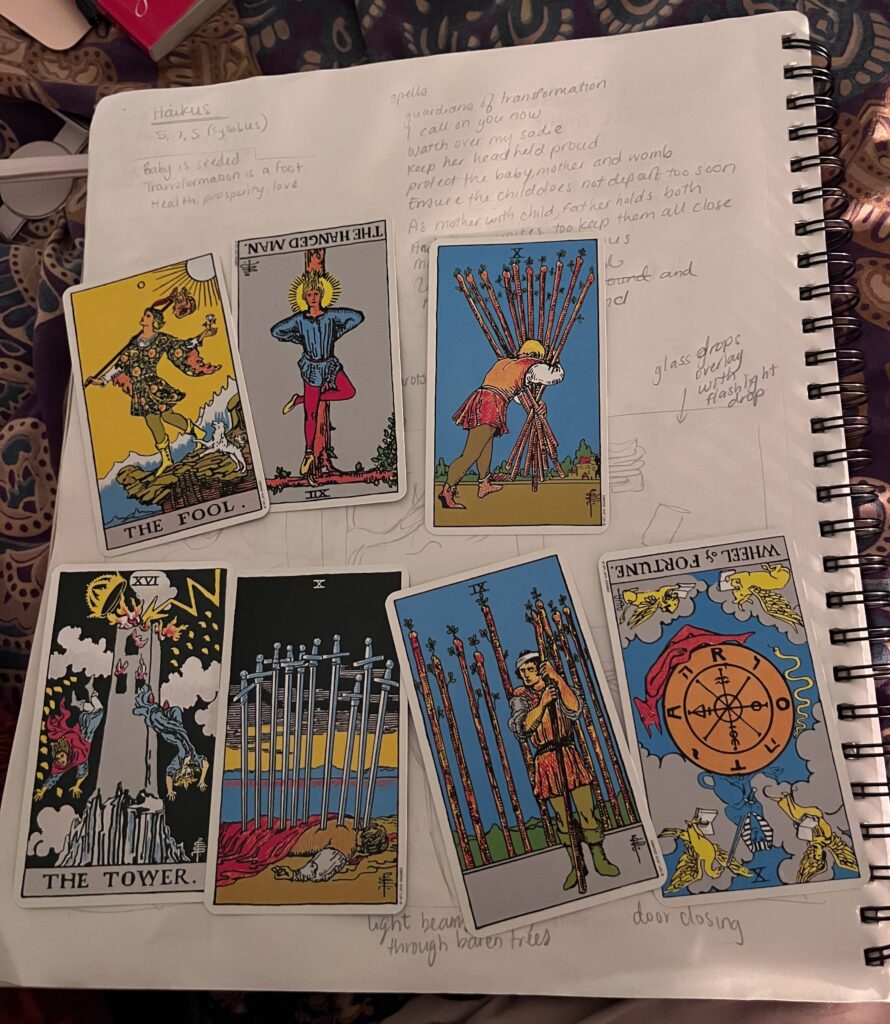
Video Poem Process
The equipment I rented for the project started with a Gimble. After taking it home and watching the instructional video that was linked by QR code to the packaging, I started to test the equiptment by walking around my block at night. Getting used to the turning function, the recording button, and some of the other features of the Gimble was tricky at first. Some of the functions shown on the video didn’t seem to work on my iphone, but it functioned well enough. This is when I found the fallen down sunflower shot, and took the door closing shot that would end up in my video. There was some 8 other clips that didn’t make the cut. The next morning I captured the video of the leaf falling. I tired capturing the natural falling of the leaf, and staging it by throwing a leaf in the air, but because of my relative closeness to the leaf, it moved too quickly out of the frame.
After taking that footage, I put it on Adobe Premier and started to work with the clips. I noticed that the footage was shakey, despite using the Gimble. Maybe I wasn’t using it correctly? In any case, Tyler showed me how I could stabilize the image using Premier Pro editing features which was a huge life saver. I also noticed that much of the shots taken in low-light looked quite grainy. I wondered if this was due to the quality of video on my phone. I noticed that my classmate, Ally, had really clear and crispt underwater shots and made a mental note to try taking some footage with the GoPro to see if I could capture some better images.
After the sharp learning curve of using Adobe Premier, and many hours in the Mac Lab, I had ordered the clips and begun to cut them down into reasonable lengths. This would be the extent of my edits for my first Mac Lab session.



In doing my edits I also made not of where I still needed shots. This included an opening shot and shots to go along with the “climax” of the video – the Tower Card. I brainstormed what I could do and decided I would go with a water theme after being inspired by my classmates underwater shot. Originally, I thought I could try and drown myself in the ocean (figuratively speaking), but then I thought that perhaps I could have a better effect (and warmer) in the bathtub. This would not only be more comfortable for me, but baths are one of my most comforting activities and simply stepping into the bath would mirror the image of the Fool – stepping forward towards the cliff. I was headed to my dad’s house in Victoria for the weekend so I could use his bath, and I packed a yellow oversized shirt to mimic the yellow tunic in the Fool’s card. I still wanted to incorporate some underwater shots of the ocean though, I thought I could do this for the “drowning” part – a self point of view of what it feels like to be thrashing under water. I also knew there would be a storm that night so planned to stay up late and capture some shots of the wind shaking the trees like I had planned in my storyboard.
Half a dozen selfies and video clips later I had my successful shots of stepping into the bathtub and drowning. I played with the idea of looking up at an unknown figure, but decided in the editing phase that it looked better if I was along and uninstructed.
Trying to use the GoPro was difficult. I needed. to watch some YouTube videos on how to change the settings on the camera, and almost all of the batteries (all three of them), were dead and I didn’t have the appropriate apparatus to charge it. Also, Tyler told me that the integrity of the camera was compromised, so I needed to be really careful that I didn’t get any soap in the water I planed to submerge it in. I wasn’t sure if there was any left over soap in the tub, but I didn’t want to risk having to pay hundreds of dollars to replace the equipment so I continued to use my phone in the bathtub shots. Fortunately, I have my own tripod, so I used that for these clips.
After the tub, I went outside at midnight to capture my storming trees in the wind shots. It was very dark and there was a street light sillouetting the tree in front of my dad’s house. It was moving pretty agressively but I wasn’t sure if the GoPro was working well enough to capture the image in the dark lighting. I tried to take the shot, went inside, checked it, and then went outside and took it again with my phone. This seemed to work better.
My next step was to capture some footage of the glass breaking. This was going to be the most staged clip since I knew I needed to do it somewhere away from my cat (so it couldn’t be at home) and with really good lighting. So, I asked Jeff where he’d recommend I do it on campus and he recommended that I do it in the painting/drawing studio and use objects to try and prevent the glass from shattering all over the room. He also provided me with a brook and shop vac to clean up after myself. I brough my shadow-box light to class with me on Tuesday and after class I set stage up in the corner of the room. I used the plinths and painting boards to block in the glass and set up the light. I used AI to look up what settings on my phone I should change to be able to capture the best shots. It said to go to 60 frames per minute (second?) and to 4K video quality. Maybe I should have been shooting at that quality all along? Anyway, I changed the settings and then set my phone up on the tripod.
I dropped the glass but the first try it bounced out of the frame and didn’t break on the cement floor. Fortunately, Yeun Ting was in the room while I was trying to take my shot and she recommended to drop it from the top of the glass where the glass was probably thinnest. She was right! The second take it worked and I had my footage! Success. That shot felt really important to the story arc and was the most technically challenging shot of the video.
The following day I returned to the Mac Lab to process my next round of shots. I still didn’t get the clip of the underwater ocean scene but I figured I could work with what I had. Unfortunately, not of the technology was working. I stayed for hours trying to trouble shoot, sent several emails, but still couldn’t get Premier Pro to work. I had my 3D art class next and we were also using the computers for that class. It turned out that Premier Pro wasn’t the only program that was suffering so on Angela’s suggestion I sent emails to Sara, Scott and Tyler to tell them about the issues I was experiencing and possible causes. After my 3D art class I tried again on two other computers but still struggled. I decided to watch a few how-to videos and try and find some sound clips since I couldn’t edit the video. After listening and downloading about 6 different songs from Pixaby and watching 5 how-to videos, I threw in the towel and went home.
The next morning Sara was offering additional assistance on the video. At this point it was Thursday and the last day before the assignment was due. I knew if I didn’t get my underwater shot before going into the Mac Lab, then it wasn’t going to make the video. So, all dressed up in my halloween costume, I headed to Puntledge River with the Go Pro. As I approached the river I saw the salmon running and hundreds of seagulls! The river was much higher and moving fast. Perfect! I put down the camera and then… shoot! I forgot to try and find a wall charger to charge the Go Pro batteries! I prayed that one of the batteries had enough juice to get the shot. I tried all three batteries, changed the settings to go to video, and then put it back in the case, I submerged it in the water, moved it all about in the surface of the water, and then pulled it out. I looked at the camera but it was dead. When I got to the lab I saw that there was no footage captured. What a bust!
Back in the lab Sara Vipond had been trouble shootting the technical issues with the computer. With her support I was able to get onto my video and add the new clips I had taken. I clipped and cropped them and got them into order. Now I was onto editing the transitions. This took the full 2.5 hours of the Mac Lab time before I got kicked out for the next class using the space. I headed to my volunteer job and settled on completing the project before class on Friday.
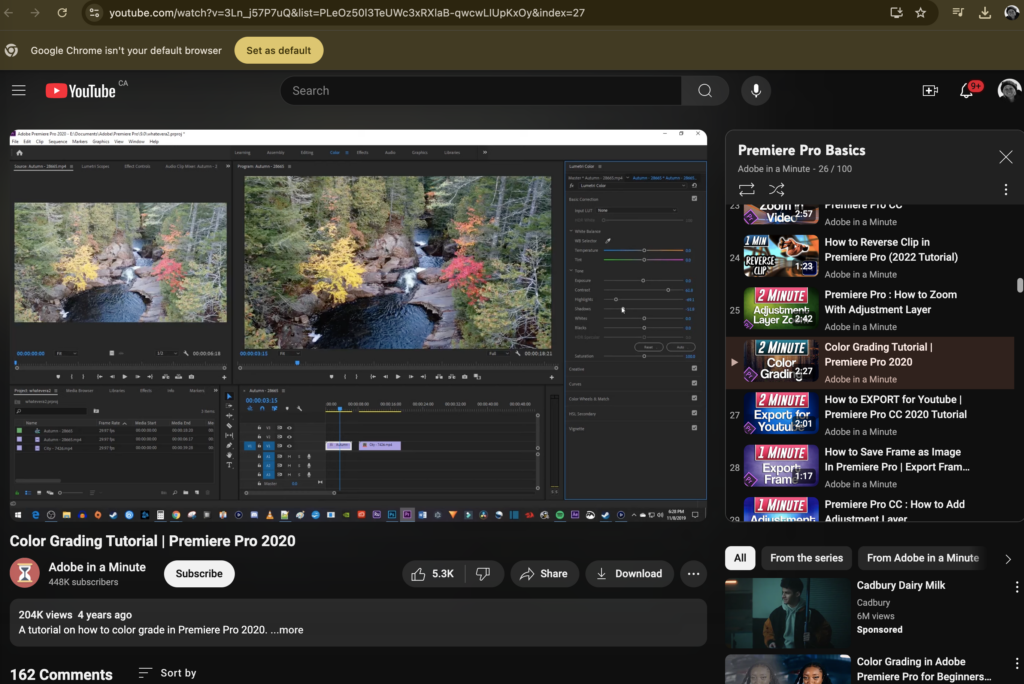

It was now Friday and I still needed to added the sound clips, finish editing the clips for colour, and slowing down and speeding up some shots. Fortunately, Ally was also in the Mac Lab making some last minute changes and I have to say, the moral support was much appreciated. She was in the lab almost every time I was and it was great to be in this whole challenging project together. I’m grateful for her and for managing to complete my edits with the hair on my chinny-chin-chin – completing the project just 30 minutes before it was due!
Video Poem Project – The Fool’s Journey
The Fools Journey
Two years ago I had a traumatic experience. As this project began, I went to a workshop to help open my blockages around communication. During the workshop I broke down in tears realizing I still struggle to speak my truth about what occurred two years ago. I decided to make this project a non-verbal way of communicating what happened from my own perspective. I wanted to share how I felt moving through that experience. I wanted to convey how it seems like what happened was a part of some bigger constellation since, at times, I felt like I had zero control over what was happening in my life. But, the truth is, I did have a role and that role was the Fools Journey. I’ve been playing with Tarot Cards and used the cards to tell my story. The Tarot Cards begin with the Fool and so that’s where I wanted to start – someone innocently galavanting on a big adventure, unaware of the looming cliffs. The tarot cards are filled with symbols with multiple interpretations. This represents how many people can have different interpretations of a single experience. After so many years I’ve never been able to tell my version of the story and this project has brought me one step closer to doing so.
I wanted to the climax of the video – the drowning and glass shattering of the Tower Card, to fall silent, to represent how during the most painful moments of my experience, I felt silenced. I chose to drown myself in a bathtub, because it did feel like my experience was a part of my own doing, no one forced me into the water, I walked in willingly. No one held me beneath the surface, I was the one trapping myself there. In this story I am both the victim and the perpetrator. I hold both roles, the same way one card can have different meanings depending on if it’s in the upright position, or the reverse.
